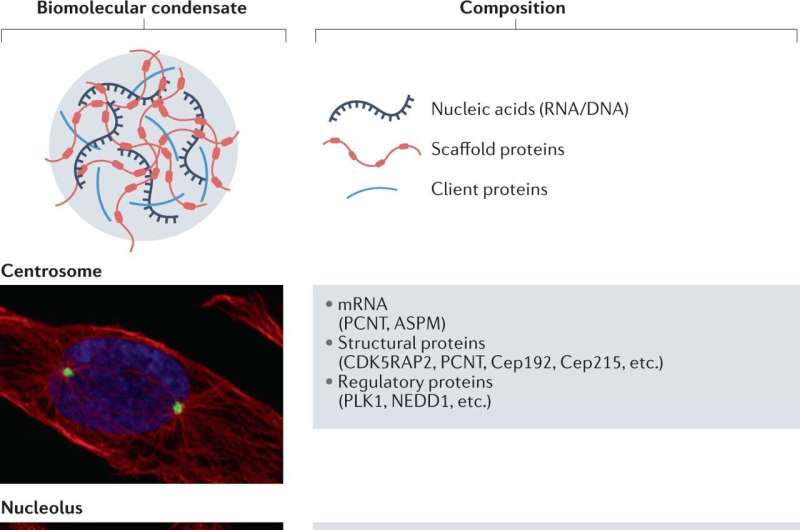Examples of complex composition of biomolecular condensates. The molecular community defines the identity of a biomolecular condensate. Examples of three biomolecular condensates and selected components. The centrosome is the central organizer of microtubules and is involved in regulation of mitosis; the image shows a mitotic SiHa cell, with the centrosome structural protein CDK5RAP2 stained green, the nucleus blue and microtubules red. The nucleolus is the site of ribosome biogenesis; the image shows U2OS cells with the nucleolar scaffold protein NPM1 stained green and microtubules red. Stress granules; the image shows stress granules in HeLa cells, visualized via G3BP1 immunofluorescence. lncRNA, long non-coding RNA; rRNA, ribosomal RNA; snoRNA, small nucleolar RNA. The centrosome image is reproduced from https://www.proteinatlas.org/ENSG00000136861-CDK5RAP2/cell#img, and the nucleolus image is reproduced from https://www.proteinatlas.org/ENSG00000181163-NPM1/cell#img. Credit: Nature Reviews Drug Discovery (2022). DOI: 10.1038/s41573-022-00505-4
A new perspective published in Nature Reviews Drug Discovery examines the potential of biomolecular condensates to transform drug discovery. Condensates are membrane-less organelles that form dynamically throughout the cell via a process called phase separation. Over the last decade scientists have recognized the role of biomolecular condensates in cellular organization and disease, marking one of the most revolutionary areas of biology.
In "Modulating biomolecular condensates: a novel approach to drug discovery," a Dewpoint Therapeutics perspective, the authors discuss the largely untapped opportunities for targeting biomolecular condensates to develop therapeutic agents for various diseases. "To our knowledge, this is the first time that a cohesive logic has been assembled outlining how a deep understanding of condensate biology can revolutionize the drug discovery process across therapeutic areas," commented Dr. Isaac Klein, Chief Scientific Officer at Dewpoint Therapeutics and corresponding author.
The authors propose that condensate dysregulation may represent a node of disease origination in patients with different genetic background and environmental exposures, and that these nodes can be leveraged as drug targets. Classical drug discovery focuses on modifying the function of a single target biomolecule. By reimagining the drug target as the molecular community that resides within a condensate, researchers can modify the function of biological pathways and biomolecules that were previously considered "undruggable." Another promising aspect of condensate drug discovery is that by targeting a disease node, a single therapeutic agent might help treat a larger patient population.
"Condensates are unlike anything seen before in drug discovery. Dewpoint is leading the understanding of condensates and the diverse ways new medicines could be developed to restore aberrant condensate function. No one has previously published the potential of biomolecular condensates from a drug discovery perspective, and Dewpoint scientists are bringing forward a groundbreaking perspective to the field," commented Dr. Mark Murcko, Dewpoint Therapeutics Board and Scientific Advisory Board member, and co-corresponding author.
The perspective summarizes the rules that underlie the formation, dissolution, and regulation of biomolecular condensates, which have emerged in the last decade. Based on these rules, the authors discuss how condensate dysfunction drives various diseases, including neurodegeneration, cancer, cardiomyopathy and viral infection. Klein comments, "Dewpoint has developed a platform and drug discovery pipeline that exploits cutting-edge technology and a deep understanding of condensate biology to discover novel condensate modifiers, or c-mods. These molecules have the ability to tackle the root cause of complex diseases and address previously undruggable targets."
Condensate-targeted drug discovery was pioneered by Dewpoint Therapeutics as the first biotech company to enter the field, in 2018. New rules for the design of condensate modifying therapeutics are continuously evolving along with the new discoveries in the field. Similarly, discovery pipelines are actively under development, bringing hope for new life-saving treatments for patients suffering from debilitating, uncurable diseases.
More information: Diana M. Mitrea et al, Modulating biomolecular condensates: a novel approach to drug discovery, Nature Reviews Drug Discovery (2022). DOI: 10.1038/s41573-022-00505-4
Journal information: Nature Reviews Drug Discovery
Provided by Dewpoint Therapeutics
























